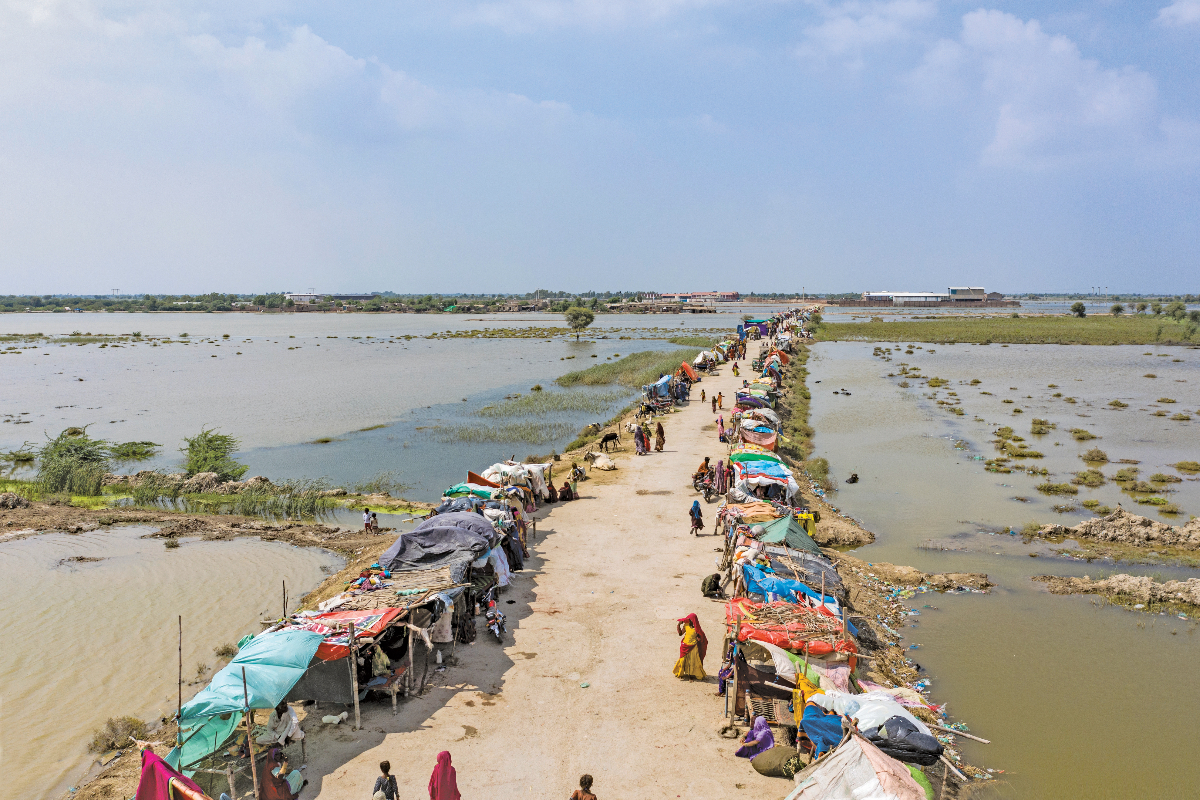
After the Deluge
Paucity of funds can cause human catastrophe in flood-affected areas: UN
ISLAMABAD: The lives of 20.6 million people are at risk in Pakistan’s flood-affected areas because of the shortage of funds and if emergency aid is not provided, food supplies to the victims will run out of stock by January, which will create disastrous situation, the United Nations (UN) said.
Unveiling the Interim Report of (September-November 2022) Floods Response Plan, Julien Harneis, humanitarian coordinator of the UN said that it is unfortunate that the international community is unaware of the gravity of situation in the flood-affected areas of Pakistan, especially in Sindh.
“Many areas are still inundated with floodwaters, damage remains widespread, disease outbreaks continue in pockets and public health is a continuing concern,” he added.
“People in many flood-affected areas can only reach their homes through boats,” he said, adding that up to 9.1 million people may be pushed below the poverty line.
Against the UN appeal for $816 million, only $262 million have been received so far, which is only 32.1 per cent of the total amount.
According to Harneis, the local and foreign media did not give due coverage to the sufferings and plight of the flood victims.
“I appeal the foreign and local media organisations to give maximum coverage to the difficulties we are facing in catering to the needs of the flood victims because of the paucity of funds.
Regarding the rehabilitation of the flood-affected victims, he said, Sindh Chief Minister Syed Murad Ali Shah is providing them full support to deal with this crisis.
Harneis said that a donors’ conference has been planned in Davos, Switzerland, on January 15, 2023 for the rehabilitation of the flood-affected people of Pakistan, where the Sindh government would present its case to get more relief from the international community.
Chris Kaye, representative of the World Food Programme (WFP), said that if immediate funding will not be provided, then the food supplies will be stopped soon.
“We will be run out of food stocks by early January 2023 because we don’t have funds to cater to the food needs of the flood victims,” he cautioned.
According to the WFP official, food insecurity and malnutrition are intensifying and an estimated 14.6 million people need food assistance from December 2022 through March 2023. Of this, the UN and partners have been targeting 4 million, who are experiencing critical food shortages.
“So far, we have only managed to reach 3.4 million of the population and in the absence of adequate support, we expect a further 1.1 million people will be struggling to find enough to eat,” he added.
In the report, it was mentioned that some 7 million children require nutrition services. Rapid screenings of the flood-affected communities and the severity of the cases reported at the treatment centres further indicate high levels of severe acute malnutrition across the flood-affected population.
The waterborne diseases remain prevalent even as health services, as well as access to water and sanitation remain disrupted; following the monsoon disaster.
According to the report, the food security and agriculture sector provided assistance to 3.4 million people against 4 million. Health support has been provided to three million people against 6.4 million. Nutrition assistance has been provided to 1.5 million people against 3.9 million. Similarly, water, sanitation and hygiene support has been provided to 1.9 million people against 3.4 million.
Further, the organisation has provided shelter and NFI assistance to 1.5 million people against 3.5 million. Education support has been provided to 135,000 people against 700,000, protection assistance, including for women and children at risk, has been provided to 0.99 million people against 8.5 million, and agricultural and livestock assistance has been benefitting 151,000 people (livestock feed and fodder, food supplements for livestock, livestock vaccination and deworming).
More funding is needed to help the people get through the winters to restore agricultural, livestock and livelihoods and to rebuild their homes and communities.
“We are especially concerned over the food and nutrition security for an increasing number of people. We don’t have enough funds to continue the assistance needed for those we have reached and we are expecting an additional 1.1 million people in the flood-affected areas who requires food assistance, the report revealed.
As reported by the Provincial Disaster Management Authority (PDMA), Sindh, an estimated 200,000 people remain displaced. Those who have returned, have returned to nothing, including destroyed or damaged homes and a complete lack of essential services such as health, protection, education, water and sanitation.
The humanitarian needs persist even as recovery and rehabilitation phase commences. “We need to keep both local and global attention on those fighting for the survival on a daily basis. In a world where there are multiple crises and each crisis is important, there are a few places with the people struggling to survive with negligible support, as they are in the flood-affected districts of Pakistan.”
“Three months after the floods, the situation has worsened. A mechanism to cope the situation has compounded by increased economic hardships and the winter season,” the report said.

Rising inflation and low productivity growth continue to create challenges to food security and basic nutrition, while many people’s livelihoods and productive assets, including livestock, were destroyed by the floods.
In addition to increasing food insecurity, for many of those who were agricultural labourer’s, this has increased their already heavy debt burden. Due to desperation more people are turning to inappropriate mechanisms to survive such as child labour, child marriages and trafficking. The risk of sexual exploitation and abuse remains high. Shelter damages and destruction are affecting over two million households and remains an impediment to return and recovery. However, hundreds of thousands are still in need of emergency solution and support.
The protection concerns and physical and psychological risks remain high, especially for women, children and the marginalised groups, including refugees, with women, girls and transgender persons and persons with disabilities at heightened risk of sexual exploitation and abuse.
Women and girls, persons with disabilities and older persons are disproportionately impacted. Only one per cent of those reporting gender-based violence have been able to access these services.
The floods intensified the pre-existing protection risks (e.g., GBV, child marriage, discrimination) and created new concerns, including exposure to flood-related hazards, sexual exploitation and abuse, loss of civil documentation and safe equitable access to the humanitarian assistance, essential services and livelihood opportunities.
Schools remain inaccessible for more than two million children, with nearly 34,296 schools in Pakistan damaged or destroyed by the floods. This increases the children’s vulnerability to exploitation and abuse and may potentially cost them their futures, according to the report.
Some 135,000 children have been supported to return to education, including through the establishment of over 750 temporary learning centres and the dewatering, desludging (cleaning) and disinfection of those schools that were only partially destroyed.
Scott Whoolery, chief field operations at UNICEF, said thatr the situation was extremely worrisome, which required immediate actions, as there was serious shortage of food for lactating mothers and the children under two years of age were facing acute malnutrition.
“We cannot turn a blind eye to the situation. The world community needs to come forward to help millions of children who need special attention,” he added.
Ambreen Niazi, advisor of the humanitarian response and operations at the Save the Children, said that it was a high time to further improve communication with the global partners and to ensure more funding, which would help one-third of the flood-affected women who were suffering from anemia and contracting different diseases due to stagnant floodwater.
Catch all the Economic Pulse News, Breaking News Event and Latest News Updates on The BOL News
Download The BOL News App to get the Daily News Update & Live News.








 Read the complete story text.
Read the complete story text. Listen to audio of the story.
Listen to audio of the story.